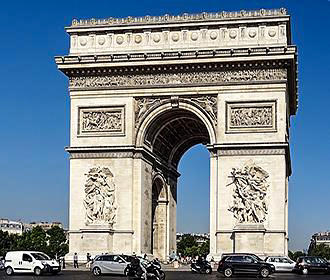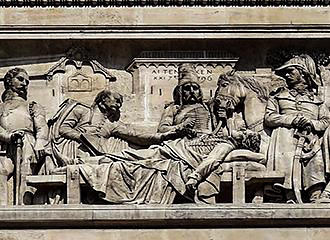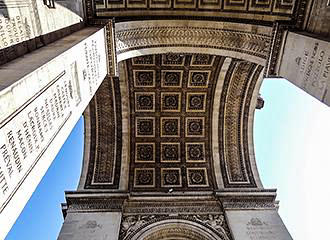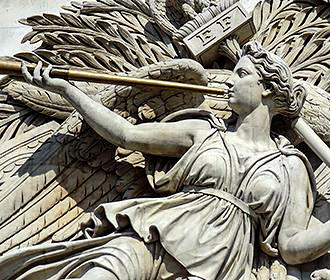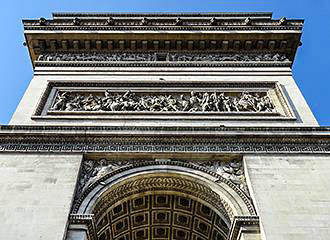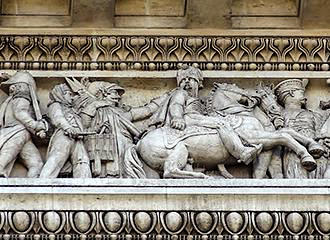History of the Arc de Triomphe in Paris
The Arc de triomphe has become one of the most famous monuments in Paris and is probably the most well known of all triumphal arches in the world. And located on the western end of the Champs Elysees at the infamous Place Charles-de-Gaulle square, it is a landmark that stands out from many others and is very hard to miss seeing when you are on holiday in Paris in the Ile de France region.
Victories of Napoleon I
The purpose for the Arc de Triomphe was to celebrate the victories of Napoleon I and his army, but unfortunately he never got to see this triumphal arc finished, but we are getting way ahead of ourselves here, so lets start at the beginning.
The Battle of Austerlitz in 1805 led to the victory for Napoleon I and it was then shortly after this victory that he declared to his soldiers, ‘you will march home through arches of victory’.
The capital city of Paris was at the heart of his empire and Napoleon I wanted this to be a grand city and in his eyes the most beautiful in the world.
So in the February of 1806 plans were put in place for a column dedicated to the Grande Armee, which is the column at Place Vendome that can still be seen today. An imperial decree was also confirmed in order to complete The Pantheon and the triumphal arch was agreed upon at this time as well.
Napoleon I originally wanted the triumphal arch to be located on the East side of Paris right near the site of the former Bastille Prison and it would be a monument that would dominate the whole of the city. With these ideas in his mind, in March 1806, it was the architect Jean-Francois Chalgrin who was chosen, to find the most suitable place for the Arc de Triomphe in Paris.
After studying several different options including those of Napoleon himself, it was decided that the Place de l’Etoile at the end of the Champs Elysees was the best location, as this was ‘the’ grand avenue that had been opened up by Colbert in the 18th century and certainly the most appropriate for victory marches.
In May 1806, the trusted architects Jean-Francois Chalgrin and Jean-Arnaud Raymond were both chosen to work alongside each other and come up with the grand ideas along with the plans, so that work could start on the Arc de Triomphe.
The ideas came from the Arch of Titus in Rome as it was based upon one arch rather than those with three arches and the highest being for the victor, and on the 15th August the first stone was laid to coincide with the birth date of Napoleon.
But in the same year work also started on the other triumphal arch known as the Arc de Triomphe du Carrousel, and this smaller Arc de Triomphe is located between The Louvre Museum and the former Tuileries Palace.
But getting back to the famous Arc de Triomphe at Place de l’Etoile
Unfortunately, it took over two years just to lay the foundations and so, when Napoleon I came back to Paris in 1810 with his new bride, the Archduchess Marie-Louise von Hapsburg of Austria, he had a wooden mock-up constructed of what the Arc de Triomphe would look like when completed.
And this also provided Jean-Francois Chalgrin the opportunity to make some last minute changes to the design, but even he never saw the completion of the triumphal arch as Chalgrin died in 1811.
But work resumed when a former pupil, by the name of Louis-Robert Goust, took over from Chalgrin, however, the progress of the Arc de Triomphe stopped again when Paris fell in 1814 after the Imperial defeat and Napoleon went into exile.
It was not until 1824 that work on the Arc de triomphe was to start again, but the new architect Jean-Nicolas Huyot proposed many major changes and these were rejected, so it was not until May 1825 that King Charles X made the order for the original plans from Chalgrin to take effect.
Eventually Jean-Nicolas Huyot was removed from the Arc de Triomphe project and it was taken over by Guillaume-Abel Blouet when he returned to Paris under the reign of King Louis-Philippe.
The architect and designer Blouet also made some changes to the original drawings like re-designing the attic level of the Arc de Triomphe, but none of the changes were as radical or controversial as those of Huyot.
And eventually, many years after work first begun on this triumphal arch, it was eventually completed and the Arc de Triomphe was inaugurated in 1836 still under the reign of King Louis Philippe.
The Arc de Triomphe has been witness to many other events throughout the years and one such event was when the remains of Napoleon I were brought back to Paris. And during this parade they marched through the Arc de Triomphe, down the Champs Elysees, through Place de la Concorde and to Les Invalides where you can get to see the Tomb of Napoleon, in a gesture of recognition to the person that first initiated its construction.
Then there is the Tomb of the Unknown Soldier and the Eternal Flame, which was actually put in place in 1920 prior to the finish of the triumphal arch, which was in recognition of soldiers who died in World War I. Not forgetting that the Eternal Flame is re-kindled in a ceremony every evening and a newly appointed French President symbolically re-lights the flame in a commemoration ceremony upon his appointment as leader of the country.
A parade to celebrate the Liberation of Paris in 1944 was conducted from the Arc de Triomphe and many other events have taken place at this monument in Paris, such as the last leg of the Tour de France each year, and when France won the FIFA World Cup in July 1998 two of the impressive reliefs, being the Departure of the Volunteers and the Return of the Armies were lit up in red, white and blue for the colours of the French flag.
Of course, being an historical monument, things deteriorated over time and restoration work has to be conducted, and it was in 2010 that the four famous sculpted groups were fully cleaned and restored to their former glory, which is not surprising that this was required, being the triumphal arch is located in the centre of one of the world's largest junctions, or intersections.
Then, in 2017, major improvements and alterations were put in place at the Arc de Triomphe to make the visitor experience even better, but also a lift, or elevator, was installed along with ramps at the top viewing area enabling those people with reduced mobility or wheelchair users to also gain access to this monument, its museum and memorable views.
So when you are going to be on holiday in France and visiting the capital city, do take the time to admire this incredible monument, and if you have the chance, even take the time to enter the Arc de Triomphe to visit the museum and go up to the viewing platform for fabulous views to other monuments and landmarks in Paris like the Sacre Coeur Basilica and the newer Grande Arche in the Defense area, or enjoy the view down the historical axis of the Champs-Elysees, past the Place de la Concorde, all the way to The Louvre.
